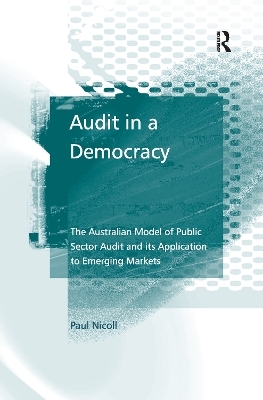
Audit in a Democracy
Routledge (Verlag)
978-0-367-60424-0 (ISBN)
Exploring the role of public sector audit in emerging democracies and developing countries, this book provides an account of the relationship between the public sector auditor, the legislature and executive government. In particular, it introduces public sector audit's capacity to assess government agencies' compliance with the law and their management of taxpayer or internationally funded programs and services. The volume: ¢ Explores the Australian model of public sector audit. ¢ Provides a definition of a supreme Audit Institution (SAI) and the role and responsibilities of the public sector auditor. ¢ Examines the authority necessary for the SAI to function effectively. ¢ Discusses likely future reform of the SAI's legal framework. ¢ Illustrates how audit can be used to strengthen democratic institutions in emerging market economies. It will be of use to researchers, academics and students interested in the critical issues surrounding audit in general and public sector audit in particular. It will also be a valuable guide to practitioners in this area.
Paul Nicoll is Executive Director of the Performance Audit Service Group in the Australian National Audit Office, Australia.
Contents: Introduction. What is the Australian Model of Public Sector Audit?: The legislature and audit in Australia; Why is there an auditor-general?; What standards does the auditor-general apply?; Money for audits; The special case of performance audits; What happens to audit opinions?; The Australian model of public sector audit summarised. What is a Supreme Audit Institution (SAI)?: Why and how can a legislature use audit?; What are the purposes of public sector audit?; Should public sector audit be at the front?; Who should pay for audits?; What are the different kinds of audits?; How do audits lead to change? living with two masters - the client and the auditee. What Authority Does the SAI Need for its Work?: What freedom should the legislature permit the SAI to have?; The planning, conduct and reporting of audits; How can the SAI reduce costs and increase its impact when it conducts two kinds of audits? What Are the Next Steps in Reform of an SAI's Legal Framework?: The legal basis for audits summarised; The next steps; Appendix: attributes of SAIs; Bibliography; Index.
| Erscheinungsdatum | 01.07.2020 |
|---|---|
| Verlagsort | London |
| Sprache | englisch |
| Maße | 156 x 234 mm |
| Gewicht | 453 g |
| Themenwelt | Naturwissenschaften ► Geowissenschaften ► Geografie / Kartografie |
| Recht / Steuern ► Arbeits- / Sozialrecht ► Sozialrecht | |
| Recht / Steuern ► EU / Internationales Recht | |
| Recht / Steuern ► Wirtschaftsrecht ► Bank- und Kapitalmarktrecht | |
| Recht / Steuern ► Wirtschaftsrecht ► Gesellschaftsrecht | |
| Wirtschaft ► Betriebswirtschaft / Management ► Planung / Organisation | |
| Wirtschaft ► Volkswirtschaftslehre | |
| ISBN-10 | 0-367-60424-8 / 0367604248 |
| ISBN-13 | 978-0-367-60424-0 / 9780367604240 |
| Zustand | Neuware |
| Informationen gemäß Produktsicherheitsverordnung (GPSR) | |
| Haben Sie eine Frage zum Produkt? |
aus dem Bereich


